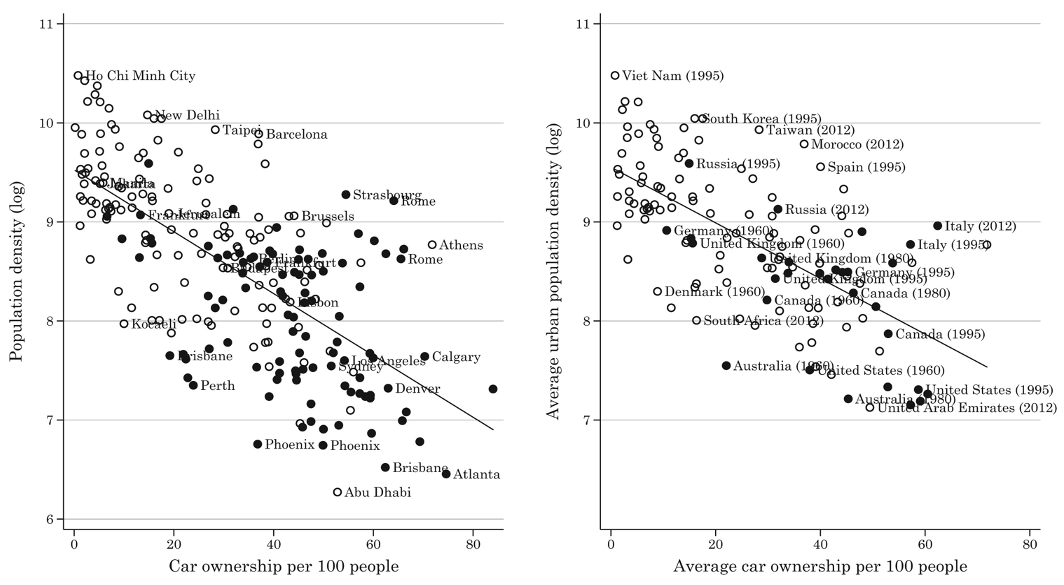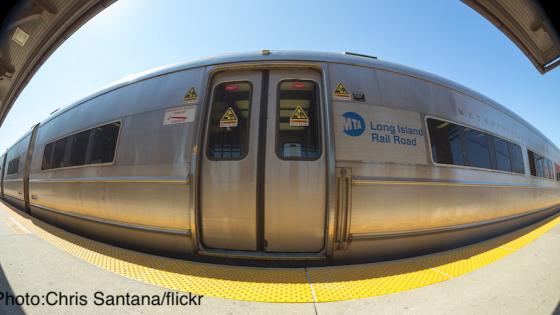One of the most radical innovations of the last century is the invention of the automobile. Cars have completely changed the way we travel to work or undertake leisure activities. Because car travel has become cheap and fast, many people now live much further from their work than they did 50 to 100 years ago. Pooley and Turnbull (2000) show that in Britain, commuting distances have increased from about 3.5km in 1900 to 15km now. An average Dutch person spends more than a week per year on their way to work. During Covid, we saw these numbers dip, but roads and highways are slowly becoming more congested. In many cities around the world, traffic congestion is once again a severe problem, and people are spending hours and hours each day in traffic jams. Furthermore, cars emit CO2 and other pollutants, making car-dominant cities unfriendly to the local and global environment.
Cars have changed the way cities are organised. Famous examples include sprawling cities in the US, such as Los Angeles and Atlanta, in which the automobile is the only feasible way to travel. It is highly plausible that cars have also caused sprawl in cities in Europe and Asia.
More cars, more spread-out cities
To date, a limited number of studies could successfully estimate the causal impact of cars on the density of cities. In a recent paper (Ostermeijer et al. 2022), we use a global dataset of 123 cities (see Figure 1) to study the impact of car ownership on population density. For these cities, we know car-ownership totals, population density, and area size.
Figure 1 Cities in our sample
If we correlate car ownership and population density, there appears to be a strong negative association (see Figure 2). This insight is not new, and others (e.g. Newman and Kenworthy 1999) have shown similar negative correlations between car use and density. However, there is a chicken-and-egg problem: if low-density, spread-out cities also encourage people to buy cars, then population density causes car ownership.
Figure 2 Car ownership and population density
Notes: The left plot shows city-year data and the right plot shows country-year data. Filled (black) circles represent cities or countries with a domestic car manufacturer in 1920. City and country labels are based on minimum, median, and maximum population densities for each bin of 10 cars per 100 people. The solid line represents the bivariate linear regression.
To really pin down the effect of cars on density, rather than the other way around, we adopt an instrumental variables approach – a statistical method that allows us to solve this issue.
More specifically, we use information on whether countries had a commercial car manufacturer in 1920. Car ownership and the construction of highways only began rising in most countries after the 1950s. As car ownership rose, so did the political leverage of large commercial car manufacturers. Throughout the middle to late 20th century, large commercial car manufacturers launched a powerful lobby – particularly in their domestic markets – to limit vehicle taxes, advocate for more road construction and parking in cities, and argue against investing in public transport. Probably the most well-known example of the automotive industry’s effect on car policies is the ‘Streetcar Conspiracy’ of 1949, when General Motors and other car manufactures were convicted of monopolising the sale of buses and accused of controlling the transit system in order to dismantle existing streetcar networks (Richmond 1995).
By adopting this instrumental variable approach, we address the chicken-and-egg problem, as the presence of a commercial car manufacturer in the 1920s cannot have been influenced by present-day population densities. Conditional on a country’s GDP, we find that the presence of a commercial car manufacturer in the 1920s led to higher car ownership levels and is associated today with lower costs of car trips, more roads, and additional highways (although the effects are somewhat imprecise). However, having a commercial car manufacturer in 1920 had no effect on population density at the time.
Using this instrument, we are able to show that cities with a higher share of car owners cause substantially lower densities: a standard deviation increase in car ownership (or about 20 cars per 100 inhabitants) reduces population density by about 35% in the long run, so the effect is sizeable. If we focus on employment density rather than population density, we come to the same conclusion: cars make cities less compact.
We find that this effect is mainly driven by expansion in urban areas rather than reductions in population size, implying that cars allow low-density expansion into the urban periphery.
Implications for developing countries and pollution
Our findings have implications for cities in developing countries, where we expect to see strong car ownership increases in the near future. If these countries follow a similar path as the countries in our study, cities will be more spread out. This in turn is likely to cause more traffic congestion, as lower density areas tend to be more car-dependent. Applying our estimates to cities in Asia, our results suggest that if car ownership increases to similar rates as seen in Western Europe, population density will fall by around 50% in the long run; if car ownership rates reach levels seen in North America and Australia, density will fall by around 60%.
More compact cities tend to be more environmentally friendly because commutes are shorter. As electric cars are unlikely to replace petrol cars in the short run (Cherif et al. 2017), cars will still generate environmental externalities, which in turn may justify higher taxes on cars.
Conclusions
Cars have a strong impact on how cities look and feel by reducing the density of people and employment. The increase in car ownership witnessed in cities all over the world in the last 50 years may have undermined the key benefits of living and working in cities. For example, it is well known that higher densities generate substantial benefits, such as positive agglomeration economies and increased public transport efficiency (Fontagné and Santoni 2016, Kuckler and Stroebel 2019). At the same time, low-density cities may not be environmentally friendly as they imply longer trips and more emissions, with more land devoted to roads and highways to keep traffic congestion at acceptable levels.
Although the rise in the number of electric cars will ease some of the costs, cities of the future should be critical towards policies that favour car use and prioritise the use of alternative transport modes such as walking, cycling, and public transport.
References
Cherif, R, F Hasanov and A Pande (2017), “Riding the energy transition: Oil beyond 2040”, VoxEU.org, 24 September.
Doyle, G R (1957), The World's Automobiles, 1880-1955: A Record of 75 Years of Car Building, Temple Press.
Fontagné, L and G Santoni (2016), “Why denser areas are more productive”, VoxEU.org, 20 November.
Kuchler, T and J Stroebel (2019), “Public transit infrastructure and urban social connectedness”, VoxEU.org, 09 August.
Newman, P and J Kenworthy (1999), Sustainability and cities: overcoming automobile dependence, Island Press.
Ostermeijer, F, H R A Koster, J van Ommeren and V M Nielsen (2022), “Automobiles and urban density”, Journal of Economic Geography, forthcoming.
Pooley, C G and J Turnbull (2000), “Modal choice and modal change: the journey to work in Britain since 1890”, Journal of Transport Geography 8(1): 11–24.
Richmond, J (1995), Transport of delight: The mythical conception of rail transit in Los Angeles, University of Akron Press.










